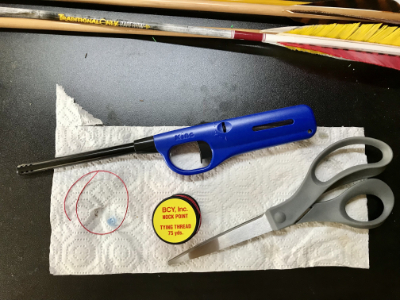With traditional archery, there’s a multitude of methods that can be employed to set up a bow and get it dialed in to meet your needs. But beyond personal preference, some methods just plain make sense. Case in point: adjustable nocking points.
When initially setting up a bow, you’re dealing with a host of changing variables. I’ve found that using an adjustable nocking point makes my life easier throughout the tuning/set up process, continuing on throughout the entire hunting season. And if you’re an ounce-counting speed freak, you’ll be pleased to know that a tie-on nocking point weighs less than the commonly used crimp-on brass nocking points.
Tying an adjustable nocking point takes only a few minutes to complete, and all that’s needed is some “nock point” thread (I use BCY Nock Point Tying Thread), scissors and a butane lighter.
- First, cut a piece of nock point thread that’s about 8”-10” long. *You can go shorter as you become adept at tying these nocking points.
- Estimate about where you’ll want your nocking point to be on the bowstring, then make a short figure “R” with the thread. The straight portion of the “R” will be held along the serving of your bow string with your thumb and forefinger, and will be relatively short in length (1”-2” long).
- Begin to wrap the long remaining portion of the thread just above where your fingers are holding the loop of the figure “R” to your bowstring, and wrap up toward the loop. You’ll wrap around the string until you have a “stack” of wraps about ¼” high.
- Thread the remainder of the longer end through the loop and pull snug. *You’ll want to pull as tight as possible, but not so tight as to tear the thread.
- Using scissors; trim the upper and lower pigtails of thread to around ¼” long.
- Take the lighter, and ignite each pigtail while being careful to extinguish the flame before the threads that make up your nocking point catch fire. Extinguish the flames with your finger and be sure to squish the molten ends into your tied nocking point.
Adjust the nocking point by twisting up or down while applying the necessary amount of pressure in the desired direction (up or down).









Sounds great but after trying one I found the nocking point would always move a quarter inch with each shot.
Tie it tighter. There’s a fine line between too loose and too tight. When you find it, you won’t go back to any brass nock points ever again.
Luke, great written how to! Once you’ve done a couple they are pretty easy to do, but trying to explain it can be awkward. I’ve been using these for a couple years after seeing a YouTube video from Bob Lee Bows. For any visual learners here is their link: https://www.youtube.com/watch?v=SoLIWPdsRMA&list=PLas0EMHkm9TL9d2VwdbrwptqAI1mmO1Jo&index=12
To Jerry M, I second Bud’s comment. Luke indicated “not so tight as to tear the thread.” but I’m using BCY serving and actually wrap the loose tag ends around a couple pencils to give me some extra leverage and snug those down TIGHT. Still able to twist them up or down as needed but never had one move on its own.
Jerry Meyer and Bud B.,
Bud hit the nail on the head. After tieing a few of these, you’ll figure out the “go-no go point” of how tight you can tie these before the thread snaps. Once you get it right, the knot won’t move unless you want it to.
I hope that both of you have a great year!
Luke J.
Bearcat64,
You made me chuckle because yes, trying to explain this can definitely be “awkward”! HAHA. Great input with that Bow Lee Bows link for the visual learners.
Great handle, by the way.
Shoot straight this year and have a great season!
Luke J